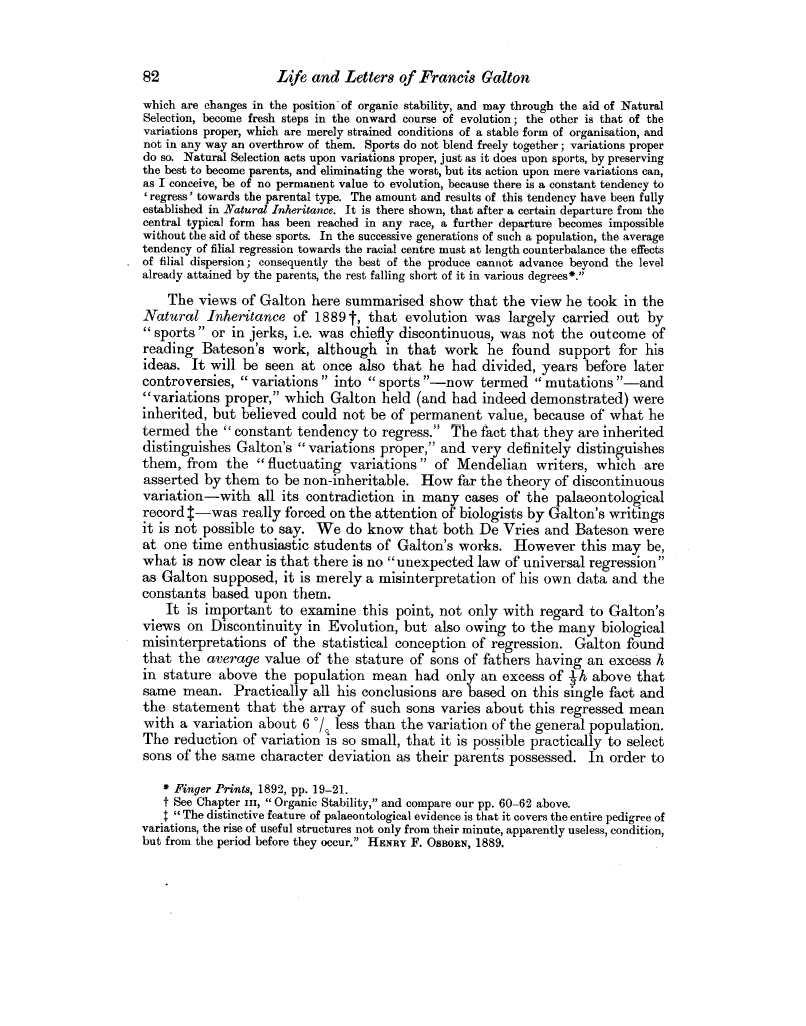| ||||||

OCR Rendition - approximate
82 Life and Letters of Francis Galton which are changes in the position of organic stability, and may through the aid of Natural Selection, become fresh steps in the onward course of evolution ; the other is that of the variations proper, which are merely strained conditions of a stable form of organisation, and not in any way an overthrow of them. Sports do not blend freely together ; variations proper do so. Natural Selection acts upon variations proper, just as it does upon sports, by preserving the best to become parents, and eliminating the worst, but its action upon mere variations can, as I conceive, be of no permanent value to evolution, because there is a constant tendency to ` regress' towards the parental type. The amount and results of this tendency have been fully established in Natural Inheritance. It is there shown, that after a certain departure from the central typical form has been reached in any race, a further departure becomes impossible without the aid of these sports. In the successive generations of such a population, the average tendency of filial regression towards the racial centre must at length counterbalance the effects of filial dispersion; consequently the best of the produce cannot advance beyond the level already attained by the parents, the rest falling short of it in various degrees*." The views of Galton here summarised show that the view he took in the Natural Inheritance of 1889t, that evolution was largely carried out by " sports " or in jerks, i.e. was chiefly discontinuous, was not the outcome of reading Bateson's work, although in that work he found support for his ideas. It will be seen at once also that he had divided, years before later controversies, " variations " into " sports "-now termed " mutations "-and "variations proper," which Galton held (and had indeed demonstrated) were inherited, but believed could not be of permanent value, because of what he termed the " constant tendency to regress." The fact that they are inherited distinguishes Galton's "variations proper," and very definitely distinguishes them, from the "fluctuating variations" of Mendelian writers, which are asserted by them to be non-inheritable. How far the theory of discontinuous variation-with all its contradiction in many cases of the palaeontological record s-was really forced on the attention of biologists by Galton's writings it is not possible to say. We do know that both De Vries and Bateson were at one time enthusiastic students of Galton's works. However this may be, what is now clear is that there is no "unexpected law of universal regression" as Galton supposed, it is merely a misinterpretation of his own data and the constants based upon them. It is important to examine this point, not only with regard to Galton's views on Discontinuity in Evolution, but also owing to the many biological misinterpretations of the statistical conception of regression. Galton found that the average value of the stature of sons of fathers having an excess h in stature above the population mean had only an excess of 3 h above that same mean. Practically all his conclusions are based on this single fact and the statement that the array of such sons varies about this regressed mean with a variation about 6 '/ less than the variation of the general population. The reduction of variation is so small, that it is possible practically to select sons of the same character deviation as their parents possessed. In order to * Finger Prints, 1892, pp. 19-21. t See Chapter in, "Organic Stability," and compare our pp. 60-62 above. " The distinctive feature of palaeontological evidence is that it covers the entire pedigree of variations, the rise of useful structures not only from their minute, apparently useless, condition, but from the period before they occur." HENRY F. OSBORN, 1889.
|